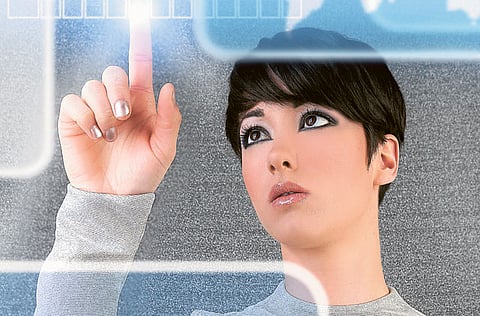What will the future look like?
Computers are 'dumb' and the internet is no longer serving humans sufficiently, says leading analyst

Computers are ‘dumb' and the internet is no longer serving humanity sufficiently, said a leading trends analyst at the Sixth Information and Communication Technology Research Forum (ICTRF) at Khalifa University (KU) last week.
Professor Peter Cochrane, chairman and director of Cochrane Associates, said mankind has become highly dependent on machines to get nearly everything done in the life. Therefore the world is currently challenged by a rising tide of complexity and enclosure of machines used for transportation, weather systems and the gathering of seismic data.
"The world is getting more complex, and technology is not slowing down," said Prof Cochrane. "We are building increasing numbers of networks to support the ever-increasing amount of data. Progress and sustainability can't be realised through old technology; so we must move away from bulk materials and the destruction of resources."
The ICTRF is an annual event aimed at preparing KU students for developing a knowledge-based economy built on information, communication and research in line with the 2030 vision aimed at diversifying the UAE economy's dependence on oil.
"We need to convert ideas into plans to build a successful knowledge based economy in the UAE," said Dr Arif Sultan Al Hammadi, chair of the ICTRF.
"In the future we will programme materials to form 3D objects of predefined shapes and functions and our ability to decode the genome in minutes will change medicine," said Prof Cochrane. "We are generating data that we have to build on for our benefit. Therefore we must build a more symbiotic relationship between humans and machines."
Prof Cochrane referred to computers as ‘dumb'. He believes in spite of their capabilities, they still put a large part of the work on their users. Likewise, he said the internet burdens surfers with much effort with the requirement of data input for information research — time that could be invested more wisely in creativity output.
"We need artificial intelligence and machines that bring new levels of creativity. We must have sensors, but not necessary processing power or memory. Sensors have to be entropic in order to make changes using models and building layers of complexity over time," he said. "Laptop computers are dumb as they don't have sensors or adaptability. We are rolling out intelligent sensors, and our future machines will see, hear, smell, detect and communicate."
The future outlined by Prof Cochrane is essentially the ushering in of the age of the internet of things, which refers to uniquely identifiable objects (things) and their virtual representations in an internet-like structure. The term was first used by Kevin Ashton in 1999.
Energy concern
Professor Khalid Bin Latif, Dean of Engineering of the Hong Kong University of Science and Technology believes wireless communication has come a long way. "We are heading towards the age of smart infrastructure — a post PC era — towards a dense ubiquitous world, where artificial intelligence will allow for communication between machines and not only between humans and machines," he said. "We are moving towards a dense wireless world where internet users will be connected in trillions. One will be able to make coffee before getting home or having machines remind us of our medicines intake schedules."
Dr Bin Latif said that the next revolution will be moving toward a virtual cyber world where anything can connected, at any time, anywhere. A world where any object can be addressed, controlled and communicated with — even plants will be connected to networks signalling their need for water.
"If every device is connected to the internet, then we can do a lot of things at all fields including homes, health, transportation, surveillance security," he said.
Dr Bin Latif highlighted the challenges of the new wireless world. His concerns are related to the enormous amounts of energy to support our daily lives and interests in order to manage data, yet provide improved mobility, security and privacy, scalability and infrastructure.
Sign up for the Daily Briefing
Get the latest news and updates straight to your inbox



